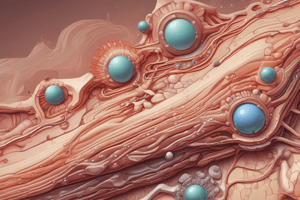Podcast
Questions and Answers
The epidermis is the innermost layer of the skin.
The epidermis is the innermost layer of the skin.
False (B)
The epidermis consists of only two layers: stratum corneum and stratum granulosum.
The epidermis consists of only two layers: stratum corneum and stratum granulosum.
False (B)
Skin has no protective role in shielding internal organs from external hazards.
Skin has no protective role in shielding internal organs from external hazards.
False (B)
The dermis consists of three layers: papillary layer, reticular layer, and adipose layer.
The dermis consists of three layers: papillary layer, reticular layer, and adipose layer.
The epidermis has direct blood supply through blood vessels.
The epidermis has direct blood supply through blood vessels.
Understanding the structure of skin provides insights into its external appearance only.
Understanding the structure of skin provides insights into its external appearance only.
The dermis is primarily composed of collagen fibers embedded in an extracellular matrix of ground substance and elastic fibers.
The dermis is primarily composed of collagen fibers embedded in an extracellular matrix of ground substance and elastic fibers.
The hypodermis, or subcutaneous tissue, consists mainly of muscle cells.
The hypodermis, or subcutaneous tissue, consists mainly of muscle cells.
The epidermis is the innermost layer of the skin.
The epidermis is the innermost layer of the skin.
Skin plays a role in excretion through sweat glands that release large amounts of water.
Skin plays a role in excretion through sweat glands that release large amounts of water.
The hypodermis attaches to the underlying endoskeleton (bone) through various ligaments and tendons.
The hypodermis attaches to the underlying endoskeleton (bone) through various ligaments and tendons.
The primary function of the skin is to regulate body temperature through muscle contractions.
The primary function of the skin is to regulate body temperature through muscle contractions.
Flashcards are hidden until you start studying
Study Notes
Skin in Biology
Skin is the largest organ in the human body, accounting for approximately 15% of total body weight. It consists of three distinct layers, each with unique structural features and functions that contribute to its overall role in maintaining homeostasis and protecting internal organs from external hazards such as pollutants, solar radiation, pathogens, and physical trauma. Understanding the structure of skin, its functions, the different layers, and their importance provides essential insights into this vital biological system.
Structure of Skin
The structure of skin is composed of three main layers: the epidermis, dermis, and hypodermis (or subcutaneous tissue). Each layer has specific characteristics that contribute to the overall function of the skin.
-
Epidermis: The outermost layer of skin, the epidermis, is a stratified squamous epithelium that provides a barrier against physical and chemical damage from the environment. It consists of four to five layers: stratum corneum (outermost layer), stratum lucidum (present only in certain skin areas), stratum granulosum, stratum spinosum, and basale layer, which rests on the basement membrane with the underlying dermis. The epidermis does not have blood vessels, relying on diffusion through sweat glands for nutrients and waste removal.
-
Dermis: The middle layer, dermis, is a connective tissue composed primarily of collagen fibers embedded in an extracellular matrix made up of ground substance and elastic fibers, providing tensile strength, flexibility, and resilience. The dermis can be divided into two main regions: papillary dermis (closest to the epidermis) and reticular dermis (deeper region). The dermis contains numerous blood vessels, nerves, hair follicles, sweat glands, and sebaceous glands that extend upward into the epidermis.
-
Hypodermis (Subcutaneous Tissue): The innermost layer, hypodermis (subcutaneous tissue), is also a connective tissue consisting mainly of fat cells that serve as energy storage sites and provide insulation, cushioning, and protection. This layer is attached to the underlying endoskeleton (bone) by various ligaments and tendons.
Functions of Skin
Skin performs many vital functions essential to human health and survival:
-
Protection: The primary function of skin is to act as a protective barrier between the internal organs and external hazards such as pollutants, solar radiation, pathogens, and mechanical injuries.
-
Regulation: Skin helps regulate body temperature through vasoconstriction and vasodilation due to the control of blood flow towards the superficially located blood vessels.
-
Smelling and Feeling: Skin plays a crucial role in sensory perception, enabling humans to detect changes in their environment through touch, pressure, heat, cold, and pain.
-
Excretion: Skin excretes small amounts of water and electrolytes through sweat glands, contributing to overall fluid balance in the body.
-
Vitamin D Production: Sunlight penetrates the skin and activates vitamin D synthesis, which is essential for calcium absorption and bone formation.
Layers of Skin and Their Importance
Each layer of skin plays a critical role in maintaining the overall health and functionality of human biology. The epidermis serves as a protective barrier against external hazards, while the dermis provides strength, flexibility, and insulation. The hypodermis, or subcutaneous tissue, stores energy and protects inner organs from mechanical injuries. These layers work together to ensure that the human body remains healthy and functional within its environment.
Studying That Suits You
Use AI to generate personalized quizzes and flashcards to suit your learning preferences.




